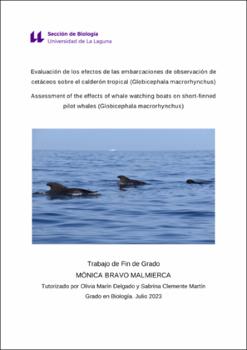Evaluación de los efectos de las embarcaciones de observación de cetáceos sobre el calderón tropical (Globicephala macrorhynchus)
Author
Bravo Malmierca, MónicaDate
2023Abstract
El avistamiento de cetáceos es una industria que produce grandes beneficios económicos gracias al turismo, sin embargo, las malas prácticas a la hora de realizar esta actividad pueden llegar a causar un impacto en diversas especies. El objetivo de este estudio es comprobar si existen cambios de comportamiento respecto al número
de embarcaciones alrededor de los grupos de cetáceos y/o respecto a la distancia que
mantienen con los mismos (< 60 m; 60–150 m). Para ello, analizamos el comportamiento de 49 grupos de calderón tropical (Globicephala macrorhynchus)
dentro de la Zona de Especial Conservación Teno-Rasca, en el suroeste de Tenerife
(Islas Canarias). Estos comportamientos se clasificaron a su vez en positivos, neutrales y negativos. Se observaron diferencias significativas entre los comportamientos positivos (26, 10, 18 y 0%) y negativos (8, 39, 27 y 40%), respectivamente para cada barco. Además, aunque las diferencias no fueron
significativas, se observaron diferentes tendencias a < 60 m (0% positivos; 62%
neutrales; 38% negativos) y entre 60–150 m (22% positivos; 62% neutrales; 16%
negativos). Por lo tanto, el presente estudio muestra evidencias que indican que el
comportamiento de los calderones podría verse significativamente alterado con el
número de barcos. Whale watching is an industry that generates significant economic benefits through tourism. However, poor practices during this activity can potentially have an impact on various species. The objective of this study is to determine if there are changes in behavior based on the number of vessels around cetacean groups and/or the distance maintained (< 60 m; 60-150 m). To achieve this, we analyzed the behavior of 49 groups of long-finned pilot whales (Globicephala macrorhynchus) within the Teno-Rasca Special Conservation Zone in the southwest of Tenerife, Canary Islands. These behaviors were classified as positive, neutral, or negative. Significant differences were observed between positive behaviors (26%, 10%, 18%, and 0%) and negative behaviors (8%, 39%, 27%, and 40%) for each boat, respectively.
Furthermore, although the differences were not significant, different trends were
observed at < 60 m (0% positive, 62% neutral, 38% negative) and between 60-150 m
(22% positive, 62% neutral, 16% negative). Therefore, this study provides evidence
indicating that the behavior of pilot whales could be significantly altered by the number
of boats present.





